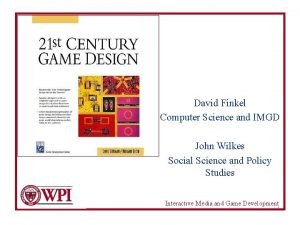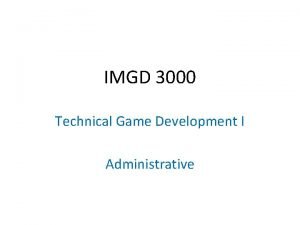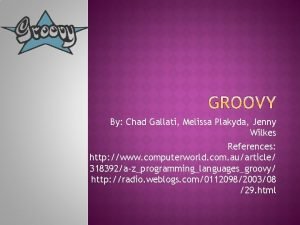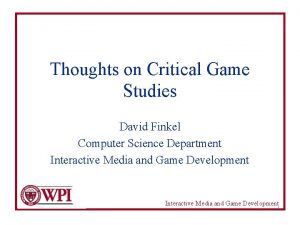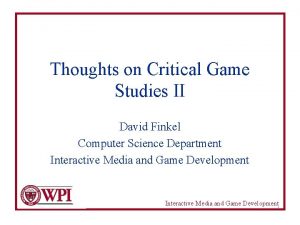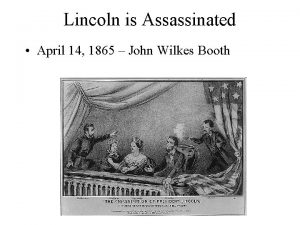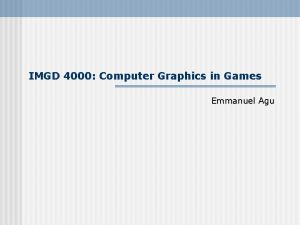David Finkel Computer Science and IMGD John Wilkes


























- Slides: 26

David Finkel Computer Science and IMGD John Wilkes Social Science and Policy Studies Interactive Media and Game Development 1

The Main Idea • There are well-established statistics on the distribution of Myers Briggs types in the population • The authors’ research connects MBTI to game play style • We are designing games for a very small proportion of the population!!! Interactive Media and Game Development 2

A Zen Story about Game Design Five wise, blind elephants were discussing what humans were like. They decided to answer the question by direct experience. The first wise, blind elephant felt the human and declared, “Humans are flat. ” The other wise, blind elephants agreed. Interactive Media and Game Development 3

Audience Models • Previous approaches: – The EA Audience Model – International Hobo Model (2000) – Market Vectors • MBTI • DGD 1 (Demographic Game Design 1, developed by International Hobo) Interactive Media and Game Development 4

The EA Audience Model Interactive Media and Game Development 5

International Hobo Model (2000) Interactive Media and Game Development 6

Market Vector Interactive Media and Game Development 7

MBTI Interactive Media and Game Development 8

MBTI Dichotomies • • Extraversion (E) vs. Introversion (I) Sensing (S) vs. i. Ntuition (N) Thinking (T) vs. Feeling (F) Judging vs. Perceiving (P) Interactive Media and Game Development 9

Representative Jobs • • INTJ: Scientist, computer programmer, mathematician ISTP: Artisan, race car driver, computer programmer ISFP: Artist, bookkeeper, crisis hotline operator INTP: Architect, college professor, computer programmer ESFP: Entertainer, musician, teacher ENFP: Journalist, clergy, character actor ENTP: Inventor, venture capitalist, art director ENFJ: Pedagogue, entertainer, artist Interactive Media and Game Development 10

Demographic Game Design 1 (DGD 1) • • Developed by International Hobo (2004) Based on on-line survey of 400 participants Survey to determine MBTI Questionnaire to determine game buying and playing habits, performed cluster analysis • Follow-up study of about 80 participants Interactive Media and Game Development 11

Type of Game Players and MBTI • Type 1 Conqueror – TJ: ISTJ, INTJ, ESTJ, ENTJ • Type 2 Manager – TP: ISTP, INTP, ESTP • Type 3 Wanderer – FP: INFP, ENFP, ISFP, ESFP • Type 4 Participant (? ) – FJ: ESFJ, ISFJ, ENFJ, INFJ • Each type further divided into hardcore and casual Interactive Media and Game Development 12

Hardcore vs. Casual • Hardcore – – Buy and play many games Enjoy a challenge, game mastery Longer play sessions Game play as a lifestyle preference • Casual – – Buy fewer games, popular games Have fun, or immersion in an interesting experience Shorter play sessions Game play as another pastime, like TV or movies Interactive Media and Game Development 13

Type 1: Conqueror • • • Winning, beating the game, domination Enjoys giving advice about games Hard fun: meaningful challenges On-line play is attractive / social Opportunity for advancement (level up / better weapons) • Vocal hardcore: post and argue about games Interactive Media and Game Development 14

Type 2: Manager • • • Prefer strategy or tactical challenges Mastery: learning how to play well Open-world games attractive Steady progress Less interested in social experience Interactive Media and Game Development 15

Type 3: Wanderer • Looking for enjoyment or interesting experience, instead of a challenge • Easy fun • Emotional experience from perception and behavior • If a Type 3 player gets stuck, might turn to a Type 1 or 2 friend for help. • Relatively few games written for this type of player Interactive Media and Game Development 16

Type 4: Participant • FJ’s are the largest group in the population, but the smallest group in the survey – They aren’t game players • Very little data • Want to participate in a story or a social grouping. Collaborative • Almost no games for this type of player Interactive Media and Game Development 17

Proportions in the population based on MBTI studies • • Type 1 Conqueror: Type 2 Manager: Type 3 Wanderer: Type 4 Participant: 24% 16% 30% Interactive Media and Game Development 18

Conclusions • Games are mostly designed for Type 1 and Type 2 players • and mostly purchased by hardcore players • These represent perhaps 15% of the population • But most game programmers and game press writers fall in these categories! Interactive Media and Game Development 19

What to do about it • The second half of 21 st Century Game Design discusses design approaches for different genres of games to appeal to the different types of players • From Ernest Adams’ GDC Talk: Interactive Media and Game Development 20

Interactive Media and Game Development 21

Interactive Media and Game Development 22

Adams’ Suggestions for Game Activities • • Overcoming challenges Exploration Enjoying natural beauty Listening to sounds, music Acquiring items (shopping) Learning skills Meeting people Interactive Media and Game Development 23

What about Game Design? • Authors suggest usual market vector • Instead of creating games for different gaming types, create games for all types • Depend on hardcore players to recommend games to casual players Interactive Media and Game Development 24

Market Vector Interactive Media and Game Development 25

David Finkel Computer Science and IMGD John Wilkes Social Science and Policy Studies Interactive Media and Game Development 26
 John byron wilkes
John byron wilkes John wilkes booth mbti
John wilkes booth mbti The furnace of civil war
The furnace of civil war Elizabeth quesenberry john wilkes booth
Elizabeth quesenberry john wilkes booth Imgd
Imgd 1001 game
1001 game Imgd
Imgd 1001game
1001game Wilkes and liberty apush
Wilkes and liberty apush Penn place
Penn place Wilkes artis
Wilkes artis Luzerne county careerlink
Luzerne county careerlink Eric wilkes
Eric wilkes Address sequencing in computer architecture
Address sequencing in computer architecture Wilkes microprogrammed control unit
Wilkes microprogrammed control unit Jenny wilkes
Jenny wilkes What is your favorite subject answer
What is your favorite subject answer John hennessy and david patterson
John hennessy and david patterson John jay science and engineering academy
John jay science and engineering academy Natural science and social science similarities
Natural science and social science similarities Think central k5
Think central k5 Hard and soft science
Hard and soft science David john frank
David john frank John 13 david guzik
John 13 david guzik David hartley y john stuart mill
David hartley y john stuart mill Computer science input and output
Computer science input and output Difference between ba and bs in computer science
Difference between ba and bs in computer science

